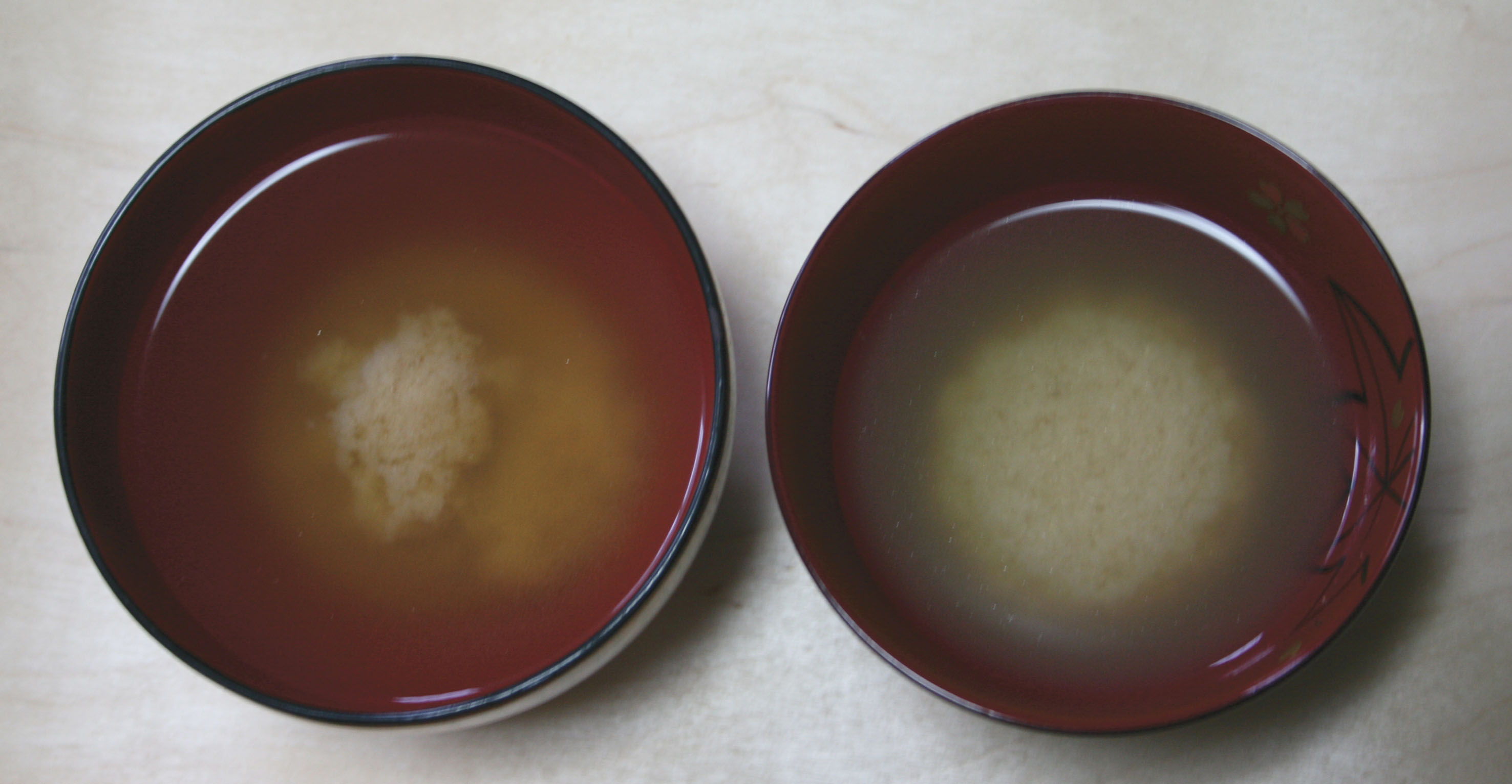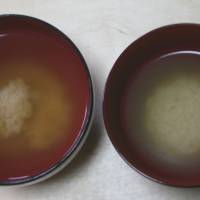Dear Alice,
My wife and I have been married long enough that our meals can be largely silent affairs, giving me plenty of time to contemplate the mysteries of my miso soup. I'd like to know what's in the cloudy bits and how the heck they move around in the soup. And why, if you let the soup sit, do the particles of miso gather in the middle leaving clear liquid on the sides? I could understand if they settled to the bottom but they seem to form a ball.
Charles S., Nagasaki
Dear Charles,
Sometimes the hardest part of researching this column is figuring how to restate the question in Japanese so I can get answers. This time, the word I most needed turned out to be "moya." By itself, that means "haze" or "mist." But when repeated — and I urge you to try this because "moya moya" is incredibly satisfying to say — it describes the cloudy bits in miso soup in a way most Japanese will understand.
There are more than 1,300 types of miso, but the basic recipe calls for grinding up cooked soybeans and mixing them with salt, grains and a starter called kōjikin (usually Aspergillus oryzaea). This is allowed to ferment, resulting in a thick paste that can be mixed into clear broth to make a commonly served soup called miso shiru.
All miso pastes contain solids that don't dissolve in the broth. I was pretty sure that's what makes up the cloudy bits you described, but I went by the Japan Miso Promotion Board in Tokyo to get details. General Manager Osamu Takanashi explained that fuyōsei busshitsu (insoluble material) makes up anywhere from 8 to 23 percent of miso paste and consists largely of parts of the soybeans and rice kernels that aren't broken down during processing and fermentation, as well as sloughed off cells of fungus and yeast.
It is indeed the solids that go moya moya in your soup, Takanashi confirmed. What's more, they're what give miso soup its distinctive taste. "The solids contain a wealth of flavor and aroma compounds," he explained. "If you let the soup sit too long, allowing it to separate so you get just broth without the solids, it won't taste nearly as good." This was solid information, but Takanashi couldn't say why the ball you observed forms, so I was still very much in the soup.
I spent the next few days slogging through scientific texts, when I stumbled on one explanation: In a book on water treatment, of all things, I found the statement that the aggregation of soybean particles in miso soup is caused by the sodium alginate in the seaweed used to make the broth. The food industry uses extracted sodium alginate to make gels, including the pimento stuffing in green olives, so the real mystery of miso soup may be why the soybean solids gather in a pleasant cloud rather than clumping together in a nasty, sticky mess.
I came across another theory on why the ball forms, which also answered your question about the moya moya moving. That explanation focuses on tairyū (convection), which I hope you remember from physics class is the concerted, collective movement of bundles of molecules within a fluid.
Imagine a cup of tea. The interior is hotter than the top because the surface is exposed to cool air. To equalize the temperature, the liquid organizes itself into zones called convection "cells" that rise to the surface and give off heat. The heat loss makes the cells denser than those below them, so they fall back down into the liquid where they get warm again. This is called thermal convection.
With a clear liquid like tea, you can't see the convection cells. But the solids in miso soup make it possible to track the movement. When the solids in your soup appear to be moving around, what you're seeing is the columns of fluid rising, falling and changing positions.
One physicist I consulted theorized that the miso solids may be settling in the region in the convection current where the upward force of current is offset by gravity.
"It appears they are clumping together into a ball, but they are in fact just moving to the same area because they have the same properties of density, size and texture," he suggested.
If that's not complicated enough, there is another mechanism at work that causes some movement at the top of your soup. Changes in temperature cause changes in hyōchōryoku (surface tension), so when one section of the surface gets cooler than another, there is flow away from the hot area toward the cold area. This is called the Marangoni effect.
That discovery launched me on another detour, this time straight into outer space. I read that experiments on exactly this effect are now in progress on Kibo, the Japanese Experiment Module on the International Space Station. So I shot right over to the Japan Aerospace Exploration Agency (JAXA).
"On Earth, it's impossible to measure the contribution of Marangoni convection because it occurs at the same time as thermal convection," Tetsuya Sakashita, an engineer in the public affairs department, explained. "But in a microgravity environment such as space, thermal convection can't occur because it depends on gravity. So we're able to study Marangoni convection in ways that are impossible on Earth."
In addition to advancing knowledge of fluid behavior, the experiments may lead to better ways of manufacturing crystals for semiconductors and other high-tech products. "At present, Marangoni convection causes quality problems during crystal growth. Once we understand more about how this phenomenon works, we may be able to reduce or eliminate such problems."
On my way out, I had to ask whether the Japanese astronauts laboring on these experiments get miso soup. "Of course," Sakashita said. "It's freeze-dried and they drink it from a pouch, but miso shiru is definitely part of the in-mission diet."




















With your current subscription plan you can comment on stories. However, before writing your first comment, please create a display name in the Profile section of your subscriber account page.